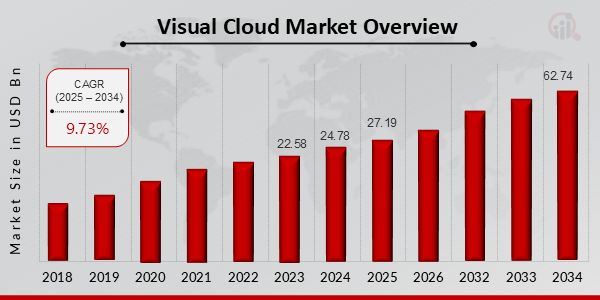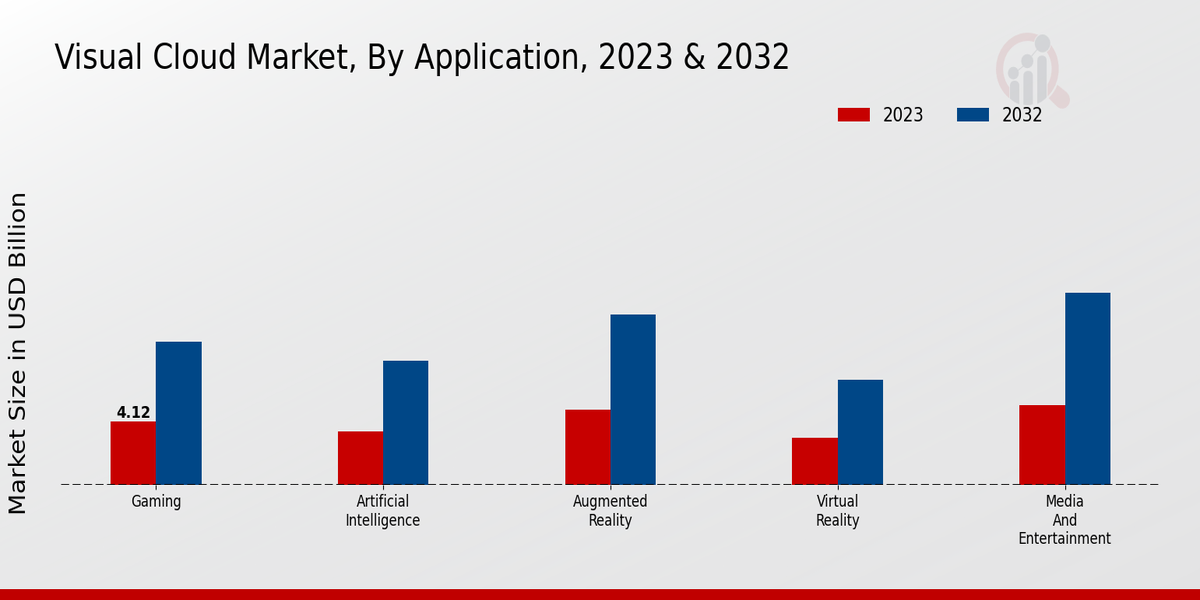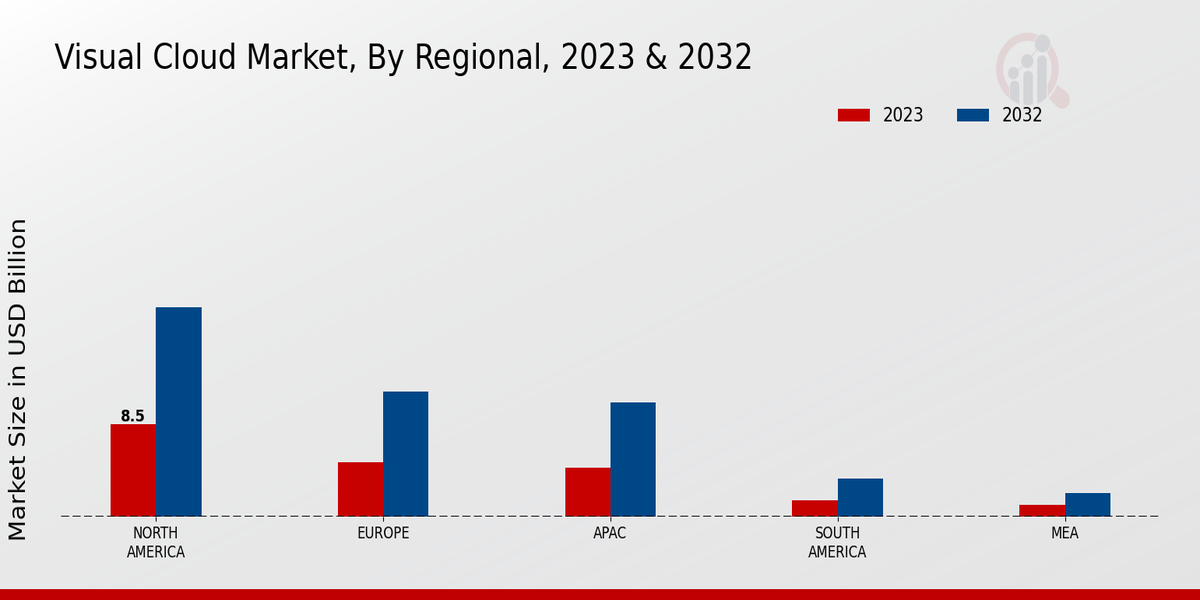Visual Cloud Market Overview
Visual Cloud Market is projected to grow from USD 27.19 Billion in 2025 to USD 62.74 Billion by 2034, exhibiting a compound annual growth rate (CAGR) of 9.73% during the forecast period (2025 - 2034). Additionally, the market size for Visual Cloud Market was valued at USD 24.78 billion in 2024.
Key Visual Cloud Market Trends Highlighted
The Visual Cloud Market is driven by the increasing demand for high-quality visual content and the rising adoption of cloud computing technologies. Organizations are leveraging visual cloud solutions to enhance user engagement, reduce latency, and improve overall performance. The shift toward remote work and digital collaboration has further accelerated the need for visual cloud services, enabling businesses to deliver rich media experiences to users anywhere, anytime. This shift emphasizes the importance of scalability and flexibility in visual cloud offerings, allowing companies to adapt quickly to changing market demands. Numerous opportunities await exploration in this dynamic landscape.
The growing interest in augmented reality and virtual reality applications presents a significant avenue for growth, as these technologies rely heavily on robust visual cloud infrastructures. Additionally, advancements in artificial intelligence can enhance content delivery and personalization, creating tailored experiences for users. The integration of 5G technology is also set to transform the visual cloud market by providing faster and more reliable connectivity, facilitating seamless streaming and enhanced interactivity. Companies that harness these advancements can unlock new revenue streams and improve customer satisfaction. Recently, there has been a noticeable trend towards sustainability and energy efficiency within the visual cloud sector.
Organizations are increasingly prioritizing eco-friendly practices, seeking solutions that minimize their carbon footprint while maximizing performance. The rise of edge computing is another noteworthy trend, allowing for faster processing and reduced latency by performing data processing closer to the source. This trend complements the overarching push for real-time experiences, making visual clouds more responsive and efficient than ever before. All these factors contribute to shaping a robust and evolving Visual Cloud Market, reflecting diverse needs and technological advancements.
Fig 1: Visual Cloud Market Overview

Source: Primary Research, Secondary Research, MRFR Database and Analyst Review
Visual Cloud Market Drivers
Increase in Demand for High-Quality Visual Experiences
The Visual Cloud Market is experiencing significant growth driven by the increase in demand for high-quality visual experiences across various sectors. With the explosion of content delivery platforms, businesses are focusing on enhancing user engagement and satisfaction through superior visual presentations. As media consumption shifts towards streaming services, video games, and augmented reality applications, the demand for high-resolution graphics and fluid animations is creating a remarkable opportunity for visual cloud solutions. Companies are adopting these technologies to keep pace with consumer expectations, which have risen due to the proliferation of advanced display technologies such as 4K and 8K resolution.
Additionally, the rise of virtual reality (VR) and mixed reality (MR) is further propelling the need for robust visual cloud platforms that can deliver immersive experiences seamlessly. This shift is not limited to entertainment; industries like education, healthcare, and real estate are also incorporating visual cloud solutions to create interactive and engaging environments for their users. By integrating artificial intelligence and machine learning, businesses are enhancing their ability to process and deliver visual data, thus streamlining operations and improving efficiency. The synergy between cloud technology and visual computing is expected to lead to innovative applications that will redefine user interactions.
As the industry moves towards the deployment of 5G networks, the capability to transmit large volumes of visual data at unprecedented speeds will further amplify the need for visual cloud services. This trend promises to fuel a competitive edge for organizations that leverage these technologies, making it a key driver in the expansion of the Visual Cloud Market.
Adoption of Cloud-Based Solutions
The shift towards cloud-based solutions is a prominent driver of growth in the Visual Cloud Market. Businesses are increasingly migrating their visual content management and delivery systems to the cloud to enhance scalability, reduce costs, and improve collaboration across teams. With the growing need for flexible and remote access to high-quality visual assets, organizations are turning towards cloud solutions that offer seamless integration with existing systems and workflows. This transition not only accelerates the deployment of visual applications but also ensures that updates and enhancements can be rolled out efficiently without significant downtime, leading to increased productivity.
Growth of the Entertainment and Media Sector
The continuous growth of the entertainment and media sector is another key driver for the Visual Cloud Market. The rising popularity of streaming services, gaming applications, and virtual events has led to a surge in demand for advanced visual content technologies. As consumers seek engaging and immersive experiences, content creators are leveraging visual cloud solutions to produce high-quality media that cater to this growing market and adapt to changing consumer preferences.
Visual Cloud Market Segment Insights
Visual Cloud Market Application Insights
The Visual Cloud Market is experiencing substantial growth, driven by the diverse applications across various sectors. Within the Application segment, notable contributors include Gaming, Artificial Intelligence, Augmented Reality, Virtual Reality, and Media and Entertainment, which play pivotal roles in market dynamics. The Gaming application held a significant valuation of 4.12 USD billion, highlighting its importance as it continues to gain traction, particularly with the rise of cloud gaming services that enhance user experiences and accessibility. The Artificial Intelligence application follows closely, valued at 3.45 USD billion, as its integration into visual processes and real-time data analysis enriches user experiences and operational efficiencies across industries.
Augmented Reality, with a valuation of 4.85 USD billion, is rapidly becoming a key player, particularly in sectors like retail and education, where immersive experience can enhance customer engagement and learning outcomes. Virtual Reality, though at a slightly lower valuation of 3.02 USD billion, was noteworthy for its applications in training and simulation exercises across industries such as healthcare and military, making it a significant area of growth. Meanwhile, Media and Entertainment, valued at 5.15 USD billion, stood as a dominant segment due to the increasing demand for high-quality, visually rich content across streaming platforms and social media.
The revenue generation from these applications reflects a shift in consumer preferences towards experiences that leverage visual cloud capabilities, with augmented and virtual reality driving substantial engagement. The potential of these segments is highlighted by projected growth trends, where the Augmented Reality application is expected to showcase a considerable increase in valuation to 11.0 USD billion by 2032, reinforcing its upward trend in the market. Each segment contributes uniquely to the overall growth and diversification of the Visual Cloud Market, supported by advancements in technologies and platforms that facilitate the use of cloud-based visual resources, thereby creating a robust framework for future developments.
This market data illustrates not only the current valuations but also hints at the significant opportunities for innovation and investment that lie ahead. The influence of emerging technologies and consumer trends will continue to shape the Application segment, making it a focal point for stakeholders seeking to capitalize on the evolving landscape of the Visual Cloud Market. Additionally, the competition among these applications fosters continuous improvement and adaptation, ensuring that the market remains responsive to changing consumer needs. The Visual Cloud Market statistics reveal a promising outlook driven by the aforementioned segments, which collectively enhance the overall growth narrative and present numerous challenges and opportunities for stakeholders in this vibrant market space.
Fig 2: Visual Cloud Market Insights

Source: Primary Research, Secondary Research, MRFR Database and Analyst Review
Visual Cloud Market Deployment Model Insights
The Deployment Model segment of the Visual Cloud Market is a critical area of focus, as it encapsulates the various methodologies through which visual cloud services are delivered. The deployment models include Public Cloud, Private Cloud, and Hybrid Cloud, each serving distinct needs and preferences. Public Cloud is gaining traction for its scalability and cost-effectiveness, allowing numerous businesses to access high-performance services without heavy upfront investments. Conversely, Private Cloud is significant for organizations seeking enhanced security and customization, offering dedicated resources that cater to sensitive data management needs. Additionally, Hybrid Cloud continues to dominate due to its flexibility, allowing businesses to enjoy the benefits of both public and private solutions.
The Visual Cloud Market data reveals trends driven by increasing digitization, cloud adoption, and the escalating demand for efficient and scalable visual computing solutions. These factors contribute to the overall growth of the Visual Cloud Market and its revenue potential, with a strong emphasis on the Deployment Model segment.
Visual Cloud Market Service Type Insights
The market comprises various essential offerings, including Infrastructure as a Service (IaaS), Platform as a Service (PaaS), and Software as a Service (SaaS). Each service type plays a crucial role in shaping the overall market dynamics, with SaaS generally dominating due to its wide adoption across industries for various applications. Additionally, IaaS offers scalable computing resources which are pivotal for businesses striving for flexibility and cost-efficiency. PaaS provides a robust platform facilitating application development, further driving innovation within the visual cloud market. As enterprises increasingly migrate to cloud-based solutions, the Visual Cloud Market reflects a strong trend towards these service types, fueled by demands for enhanced performance, reduced operational complexities, and improved accessibility.
Recent market growth has been propelled by advancements in technology and a surge in digital transformation initiatives across sectors. The significance of this segmentation in the overall market underscores the critical role these service types play in delivering effective visual cloud solutions.
Visual Cloud Market End Use Industry Insights
Various sectors, including Education, Healthcare, Retail, Telecommunications, and Transportation, are leveraging visual cloud technology to enhance their operations and drive innovation. The Education sector utilizes visual cloud solutions for remote learning, enhancing accessibility and engagement, while Healthcare benefits through improved patient data management and telehealth services, leading to better patient outcomes. Retailers are increasingly adopting visual cloud technologies for personalized marketing and enhanced customer experience. Telecommunications companies rely on these solutions to improve network efficiency and bandwidth management.
Additionally, the Transportation sector sees a strong application of visual cloud for real-time logistics and fleet management. The collective influence of these industries underlines the importance of the Visual Cloud Market segmentation, which supports a diverse range of applications critical for operational efficiencies and improved service delivery across the board. The growing trend toward digital transformation, coupled with ongoing advancements in technology, presents numerous opportunities for market expansion. However, challenges such as data security and infrastructure adaptation must be addressed to fully realize the market's potential.
Visual Cloud Market Regional Insights
The Visual Cloud Market revenue is expected to showcase significant growth across various regions, reflecting the increasing adoption of visual cloud technologies. In 2023, North America led the market with a valuation of 8.5 USD billion, signifying a dominant position due to the high demand for cloud solutions in business operations. Europe followed with a valuation of 5.0 USD billion, driven by robust investments in digital infrastructure and innovation. The APAC region, valued at 4.5 USD billion in 2023, demonstrated a growing appetite for cloud technologies bolstered by rapid digital transformation initiatives.
South America, valued at 1.5 USD billion, was also emerging, although it represents a smaller share of the overall market. Finally, the MEA region, valued at 1.09 USD billion, exhibited potential for growth as regional markets began to adopt visual cloud services. Overall, the Visual Cloud Market data reflects a healthy growth trajectory, influenced by advancements in technology and the increasing need for scalable solutions across different industries, making each of these regions critical to the industry's ongoing development.
Fig 3: Visual Cloud Market Regional Insights

Source: Primary Research, Secondary Research, MRFR Database and Analyst Review
Visual Cloud Market Key Players and Competitive Insights
The Visual Cloud Market has experienced significant growth in recent years as businesses increasingly adopt cloud-based visual solutions to enhance their digital experiences. This market encompasses various technologies and services that leverage the power of cloud computing to deliver visual content, including graphics, video streaming, and interactive tools. Key factors driving this growth include an increasing demand for high-quality visual content across industries, the rise of remote work and online collaboration, and the need for scalable and flexible infrastructure solutions.
As a result, competition within this market has intensified, with major players continuously innovating and expanding their service offerings to capture a larger share of the market and meet the evolving needs of their clients. Microsoft stands out as a formidable competitor in the Visual Cloud Market. The company's extensive portfolio of cloud services, particularly through Azure, provides robust capabilities for developers and businesses looking to create and manage visual content effectively.
Microsoft leverages its long-standing reputation for reliability and security, allowing organizations to trust its platform for critical visual applications. The integration of advanced technologies such as AI and machine learning enhances Microsoft's offerings, enabling better content personalization and optimization. Furthermore, the company’s commitment to continuous innovation ensures that it stays ahead of the curve, driving customer satisfaction and fostering brand loyalty in an increasingly crowded market. Its strong partnerships and community ecosystem further strengthen its presence, placing Microsoft in a favorable position to address the diverse needs of its customers across various verticals.
Oracle also plays a significant role in the Visual Cloud Market by providing advanced cloud solutions tailored for businesses requiring robust and efficient visual content management. The company's comprehensive suite of cloud services emphasizes data optimization and real-time analytics, empowering organizations to deliver interactive and high-quality visual experiences. Oracle's strength lies in its ability to integrate product offerings seamlessly, enabling clients to leverage their existing data while enhancing their visual strategies. Additionally, Oracle's focus on security and compliance gives businesses confidence in utilizing its platform for sensitive visual content.
The company's investment in emerging technologies, such as AI, supports the enhancement of visual applications, allowing for dynamic content delivery and better user engagement. By consistently evolving its solutions and prioritizing customer needs, Oracle solidifies its competitive edge in the Visual Cloud Market.
Key Companies in the visual cloud market Include
-
Microsoft
-
Oracle
-
Dropbox
-
IBM
-
Adobe
-
Google
-
Salesforce
-
Alibaba
-
Cisco
-
VMware
-
Intel
-
NVIDIA
-
SAP
-
Tencent
-
Amazon
Visual Cloud Market Developments
The Visual Cloud Market has recently witnessed various significant developments and current affairs. Microsoft continues to enhance its Azure cloud services, focusing heavily on AI integration, while Adobe has expanded its Creative Cloud offerings to improve collaborative features for remote teams. Oracle has been making strides in cloud applications with an emphasis on enterprise solutions. On the acquisition front, VMware has transitioned under new ownership, which is expected to streamline its operations. Intel and NVIDIA are competing vigorously to bolster their cloud infrastructure through partnerships aimed at increasing processing power and efficiency.
Salesforce's strategic inclusions in cloud analytics have gained increased attention, helping companies drive better decisions based on data insights. Meanwhile, Alibaba is expanding its cloud services in Southeast Asia, showcasing growth opportunities in emerging markets. Additionally, Amazon continues to dominate with AWS innovations, leading to higher market valuation. Cisco's recent collaborations aim to enhance connectivity and security within cloud environments, making it a critical player. With all these developments, the market reflects a growing trend towards integrated, AI-driven cloud solutions that support scalability and real-time collaboration across industries.
Visual Cloud Market Segmentation Insights
Visual Cloud Market Application Outlook
- Gaming
- Artificial Intelligence
- Augmented Reality
- Virtual Reality
- Media and Entertainment
Visual Cloud Market Deployment Model Outlook
- Public Cloud
- Private Cloud
- Hybrid Cloud
Visual Cloud Market Service Type Outlook
- Infrastructure as a Service
- Platform as a Service
- Software as a Service
Visual Cloud Market End Use Industry Outlook
- Education
- Healthcare
- Retail
- Telecommunications
- Transportation
Visual Cloud Market Regional Outlook
- North America
- Europe
- South America
- Asia Pacific
- Middle East and Africa
|
Report Attribute/Metric
|
Details
|
|
Market Size 2024
|
24.78 (USD Billion)
|
|
Market Size 2025
|
27.19 (USD Billion)
|
|
Market Size 2034
|
62.74 (USD Billion)
|
|
Compound Annual Growth Rate (CAGR)
|
9.73% (2025 - 2034)
|
|
Report Coverage
|
Revenue Forecast, Competitive Landscape, Growth Factors, and Trends
|
|
Base Year
|
2024
|
|
Market Forecast Period
|
2025 - 2034
|
|
Historical Data
|
2019 - 2023
|
|
Market Forecast Units
|
USD Billion
|
| Key Companies Profiled |
Microsoft, Oracle, Dropbox, IBM, Adobe, Google, Salesforce, Alibaba, Cisco, VMware, Intel, NVIDIA, SAP, Tencent, Amazon |
| Segments Covered |
Application, Deployment Model, Service Type, End Use Industry, Regional |
| Key Market Opportunities |
Increased demand for remote collaboration, Growth in virtual reality applications, Expansion of edge computing technologies, Rise in AI-driven analytics, and Adoption of cloud gaming services. |
| Key Market Dynamics |
Growing demand for scalable infrastructure, increasing adoption of cloud services, rising need for data visualization tools, advancements in AI and analytics, and expanding remote work culture |
| Countries Covered |
North America, Europe, APAC, South America, MEA |
Frequently Asked Questions (FAQ) :
The Visual Cloud Market is expected to be valued at 62.74 USD billion in 2034.
The expected CAGR for the Visual Cloud Market from 2025 to 2034 is 9.73%.
The Augmented Reality segment is projected to grow to 11.0 USD billion by 2032.
The Gaming segment is expected to be valued at 9.25 USD billion in 2032.
The North American region is expected to reach a market value of 19.3 USD billion by 2032.
Major players in the Visual Cloud Market include Microsoft, Oracle, Dropbox, IBM, Adobe, and Google.
The South American region is expected to be valued at 3.5 USD billion in 2032.
The Media and Entertainment application is projected to be valued at 12.44 USD billion in 2032.
The Artificial Intelligence application was valued at 3.45 USD billion in 2023.
The Visual Cloud Market was valued at 22.58 USD billion in 2023.

















